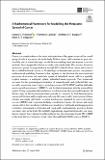Files in this item
A mathematical framework for modelling the metastatic spread of cancer
Item metadata
| dc.contributor.author | Franssen, Linnea Christin | |
| dc.contributor.author | Lorenzi, Tommaso | |
| dc.contributor.author | Burgess, Andrew | |
| dc.contributor.author | Chaplain, Mark Andrew Joseph | |
| dc.date.accessioned | 2019-03-26T17:30:06Z | |
| dc.date.available | 2019-03-26T17:30:06Z | |
| dc.date.issued | 2019-06 | |
| dc.identifier | 258100363 | |
| dc.identifier | 711e5b19-f9d3-40a3-8b9d-f72bc6fbdc40 | |
| dc.identifier | 85065132388 | |
| dc.identifier | 000466425500013 | |
| dc.identifier.citation | Franssen , L C , Lorenzi , T , Burgess , A & Chaplain , M A J 2019 , ' A mathematical framework for modelling the metastatic spread of cancer ' , Bulletin of Mathematical Biology , vol. 81 , no. 6 , pp. 1965-2010 . https://doi.org/10.1007/s11538-019-00597-x | en |
| dc.identifier.issn | 0092-8240 | |
| dc.identifier.other | ORCID: /0000-0001-5727-2160/work/55901241 | |
| dc.identifier.uri | https://hdl.handle.net/10023/17378 | |
| dc.description.abstract | Cancer is a complex disease that starts with mutations of key genes in one cell or a small group of cells at a primary site in the body. If these cancer cells continue to grow successfully and, at some later stage, invade the surrounding tissue and acquire a vascular network, they can spread to distant secondary sites in the body. This process, known as metastatic spread, is responsible for around 90% of deaths from cancer and is one of the so-called hallmarks of cancer. To shed light on the metastatic process, we present a mathematical modelling framework that captures for the first time the interconnected processes of invasion and metastatic spread of individual cancer cells in a spatially explicit manner—a multigrid, hybrid, individual-based approach. This framework accounts for the spatiotemporal evolution of mesenchymal- and epithelial-like cancer cells, membrane-type-1 matrix metalloproteinase (MT1-MMP) and the diffusible matrix metalloproteinase-2 (MMP-2), and for their interactions with the extracellular matrix. Using computational simulations, we demonstrate that our model captures all the key steps of the invasion-metastasis cascade, i.e. invasion by both heterogeneous cancer cell clusters and by single mesenchymal-like cancer cells; intravasation of these clusters and single cells both via active mechanisms mediated by matrix-degrading enzymes (MDEs) and via passive shedding; circulation of cancer cell clusters and single cancer cells in the vasculature with the associated risk of cell death and disaggregation of clusters; extravasation of clusters and single cells; and metastatic growth at distant secondary sites in the body. By faithfully reproducing experimental results, our simulations support the evidence-based hypothesis that the membrane-bound MT1-MMP is the main driver of invasive spread rather than diffusible MDEs such as MMP-2. | |
| dc.format.extent | 46 | |
| dc.format.extent | 4226725 | |
| dc.language.iso | eng | |
| dc.relation.ispartof | Bulletin of Mathematical Biology | en |
| dc.subject | Metastatic spread | en |
| dc.subject | Mathematical oncology | en |
| dc.subject | Tumour microenvironment | en |
| dc.subject | Individual-based model | en |
| dc.subject | Multigrid framework | en |
| dc.subject | QA Mathematics | en |
| dc.subject | QH301 Biology | en |
| dc.subject | RC0254 Neoplasms. Tumors. Oncology (including Cancer) | en |
| dc.subject | 3rd-DAS | en |
| dc.subject | BDC | en |
| dc.subject | R2C | en |
| dc.subject | SDG 3 - Good Health and Well-being | en |
| dc.subject.lcc | QA | en |
| dc.subject.lcc | QH301 | en |
| dc.subject.lcc | RC0254 | en |
| dc.title | A mathematical framework for modelling the metastatic spread of cancer | en |
| dc.type | Journal article | en |
| dc.contributor.sponsor | EPSRC | en |
| dc.contributor.institution | University of St Andrews. Applied Mathematics | en |
| dc.contributor.institution | University of St Andrews. School of Mathematics and Statistics | en |
| dc.identifier.doi | 10.1007/s11538-019-00597-x | |
| dc.description.status | Peer reviewed | en |
| dc.identifier.grantnumber | EP/N014642/1 | en |
This item appears in the following Collection(s)
Items in the St Andrews Research Repository are protected by copyright, with all rights reserved, unless otherwise indicated.

